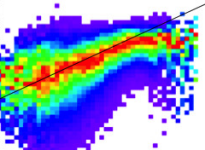Electron heat flux in the solar wind: Data vs. Simulations

Numerical simulations, which include the effects of binary collisions, are able to reproduce qualitatively and quantitatively the electron heat flux in the solar wind observed at 1 AU.
The WIND spacecraft has obtained recent measurements of the electron heat flux in the solar wind. Once normalized with respect to their saturation level and plotted against the Knudsen number (the ratio between the electron mean free path and the temperature gradient scale) they show the existence of a transition. In the wind where collisions are rare (high Knudsen number) the normalized heat flux appears constant while as the Knudsen decreases it seems to correlate well with the heat flux predicted for a full collisional plasma. By numerical simulations that take into account the Coulomb binary collisions between particle we was able to reproduce qualitatively and quantitatively the observation made by WIND. Closer inspection of the synthetic data reveals that for the parameters of the solar wind the full collisional limit is not a valid closure. The figures below show the normalized heat flux obtained by numerical simulations (
Landi et al., ApJL 2014) and that obtained by the WIND spacecraft (
Bale et al., ApJL 2013).